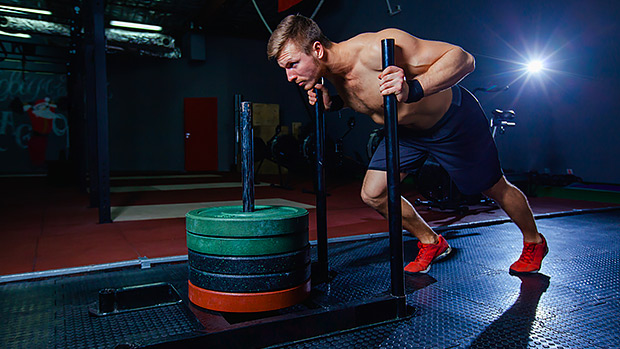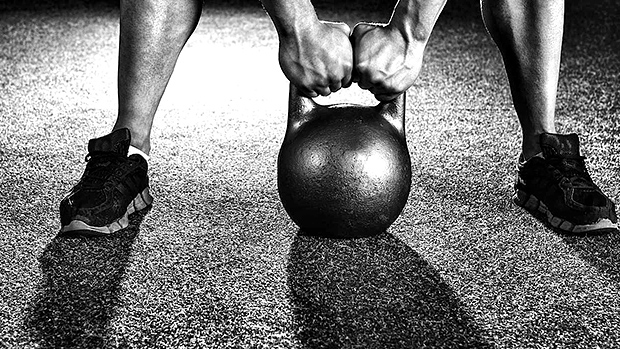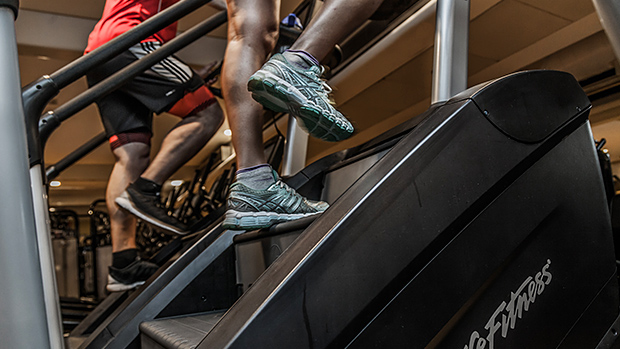Sled exercises are a great excuse to get outdoors and remind others of your physical superiority. Sled pushing and pulling are usually done for conditioning and to enhance sprinting ability, but they can also be used for ballistic exercises.
Ballistic muscle contractions are performed with maximum intent for speed and acceleration through the entire range of motion. They typically require jumping or throwing a projectile, such as a medicine ball.
The sled can be used for ballistic work because it allows you to push or pull with minimal need for a "braking" phase at the end of the rep. This creates heightened muscle recruitment throughout the rep and a potent stimulus for power development.
You'll need a sled and straps (suspension trainer straps work well). The amount of weight will depend on the type of sled, ground surface, and your strength.
Instead of defining reps and sets, do these exercises for distance. Start with 20 yards (about 18 meters) and try to cover the distance in as few reps as possible.
Alternate between push and pull exercises and simply coil the straps on top of the sled when not needed. Complete 3-5 sets of each, then add some traditional sled pushes and sled pulls for a full-body workout.
1. Sled Ballistic Row
Grab the straps. Set your feet slightly wider than your squat stance and sit back into a quarter squat. At the beginning of the rep, make sure there's no slack in the straps. Brace your midsection and aggressively pull the sled toward you. Stand tall, step back, and repeat.
2. Sled Ballistic Lat Pull
Instead of pulling from a quarter squat, hinge deeper at the hips and raise your arms overhead. Push your hips back as far as you can.
There should be no slack in the straps at the beginning of the pull, and you should feel pre-stretch on the lats. Without a change to torso position, accelerate the sled toward you by pulling your elbows down toward the sides of your ribcage. Stand tall, step back, and repeat.
3. Sled Ballistic Chest Press
The key here is achieving a solid base of support by getting into a lunge stance. Grasp near the top of the upright handles and push your chest forward so that your hands are in a position similar to a neutral-grip incline bench press (i.e. Swiss bar).
Brace and aggressively push, releasing the sled at the end of the movement. Take a step or two to reset and repeat.
4. Sled Ballistic Shoulder Press
Here's another shoulder-friendly pressing variation. Get into a deep hip hinge, attempting to get your torso as close to parallel with the ground as possible. Your head should be between the upright handles with your hands outside of your shoulders.
Brace and press hard and fast, releasing the sled at the end of the movement. Take a step or two to reset and repeat.
5. Sled Ballistic Biceps Curl
Set up by grabbing the straps and back-stepping until they're tensioned with your arms outstretched. Squat and bring your elbows to the inside of your thighs. Be sure to push the hips back into the squat to keep tension on the straps. Curl toward your collar bones (not your teeth). Stand, step back and repeat.
6. Sled Ballistic Triceps Extension
Face away from the sled with the straps held at the sides of your head. Get into a lunge position with as much forward lean as you can with tension on the straps. Brace your midsection and extend your elbows as if you were performing an aggressive overhead throw. To set up for the next rep, lunge forward to tension the straps again as you allow your elbows to bend. Repeat.
A bonus of these sled exercises is that they are concentric-only, meaning you can expect a fairly short recovery after the workout.
Related:
Total-Body Sled Training
Related:
Viking Day: Rope and Sled Training
Reference
- Maloney SJ et al. Ballistic exercise as a pre-activation stimulus: a review of the literature and practical applications. Sports Med. 2014;44(10):1347-59.




